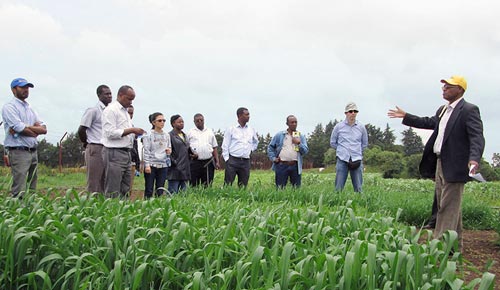By Sika Gbegbelegbe, Kindie Tesfaye and Uran Chung/CIMMYT

A workshop on modeling promising maize and wheat technologies brought together modelers, breeders, physiologists and socio-economists in Addis Ababa, Ethiopia, from 27 to 30 August. The workshop was organized by the CGIAR Research Program on Policies, Institutions and Markets (PIM). Workshop attendees reviewed progress made on modeling maize and wheat technologies; reached agreement on the conceptual framework developed for modeling benchmark, promising and ‘ideal’ technologies; identified and prioritized traits and crop management practices for foresight analysis of maize and wheat systems; identified plausible adoption pathways relative to estimating the benefits of investments in promising and “ideal” technologies; and facilitated interaction and data exchange among scientists working in different fields.
Bekele Shiferaw presented on workshop objectives, the importance of foresight analysis – or studies on the future of agriculture – in identifying priorities, threats to food security and the role modeling plays in foresight. Progress on modeling maize and wheat technologies was presented by Sika Gbegbelegbe, Kindie Tesfaye and Uran Chung from CIMMYT. Senthold Asseng, a crop modeler from the University of Florida, shared insights on the methodological concepts used in crop modeling. CIMMYT’s Kai Sonder presented progress on improving maize and wheat mega-environments – or specially classified maize and wheat growing regions – and domains that are important for geospatial crop modeling. Breeders and physiologists shared their insights on relevant traits and performance characteristics of improved germplasm. P.H. Zaidi and Biswanath Das presented on maize while Bekele Abeyo and Marta Lopes presented on wheat. Participants also discussed the bioeconomic impact of climate change, including the impact of weather extremes on food security in the developing world.
Participants visited ongoing wheat and maize research activities at the Kulumsa and Melkassa Agricultural Research Centers. CIMMYT collaborates with both research centers, which are part of the Ethiopian Agricultural Research Institute (EIAR). Attendees talked about the role of modeling in foresight, breeding and physiology, trait identification for modeling, model data requirements, data availability and data gaps during working sessions. The maize working group agreed on minimum datasets that need to be collected in field trials for modeling and progress on breeding improved germplasm with tolerance to drought, heat and other stresses. It also agreed on the need to revise the current maize mega-environments.
The wheat working group focused its discussion on tolerance to drought and heat stresses and key traits that influence yield potential. The wheat breeders and physiologists shared their knowledge on key traits and reached an agreement with the crop modelers on how such traits should be translated in crop models.
 Capacity development
Capacity development 
